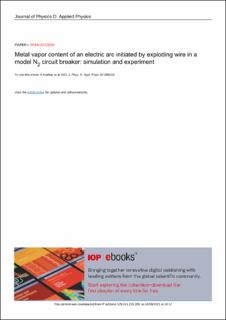| dc.contributor.author | Kadivar, Ali | |
| dc.contributor.author | Niayesh, Kaveh | |
| dc.contributor.author | Abid, Fahim | |
| dc.date.accessioned | 2021-03-18T10:19:11Z | |
| dc.date.available | 2021-03-18T10:19:11Z | |
| dc.date.created | 2020-09-23T06:32:19Z | |
| dc.date.issued | 2020 | |
| dc.identifier.issn | 0022-3727 | |
| dc.identifier.uri | https://hdl.handle.net/11250/2734135 | |
| dc.description.abstract | A conductive wire can explode by rapidly heating it to vaporization temperature by flowing a current through it. This process is utilized to generate high-temperature high-density plasmas. The temperature and pressure distributions at the time of the explosion are not easily measured. Moreover, the amount of metal vapor from the wire that remains within the arcing area is unknown. This work presents the whole-process model of a single-wire electrical explosion from solid-state to plasma formation. For this purpose, the voltage drop and resistance of the exploding copper wire in solid-state are simulated through a zero-dimensional thermo-electrical model. Then, compressible Euler equations are implemented with nodal discontinuous Lagrange shape functions in a one-dimensional model to compute the flow of the generated copper vapor (due to the wire explosion) in surrounding nitrogen gas. The aim is to calculate the distributions of pressure, density, velocity, temperature, and mass flow along the cylindrical shock waves to estimate the arc's copper/nitrogen mixture ratio in free burning and nozzle constricted arcs. This mixture ratio is used to calculate the precise percentage of the metal vapor in the arcing area and to calculate Townsend growth coefficients utilizing to estimate the streamer breakdown of the mixture. The simulation results show good agreement with the experimental results in terms of the temporal evolution of the plasma channel boundary, the shock front speed estimation as well as the arc voltage magnitude numerically calculated deploying the extracted mixture percentage from this study, manifesting the validity of the model. It shows that despite the low-pressure studies, the exploding wire method is not suitable for circuit breakers employing supercritical fluids as the insulation. | en_US |
| dc.language.iso | eng | en_US |
| dc.publisher | IOP Publishing | en_US |
| dc.rights | Navngivelse 4.0 Internasjonal | * |
| dc.rights.uri | http://creativecommons.org/licenses/by/4.0/deed.no | * |
| dc.title | Metal vapor content of an electric arc initiated by exploding wire in a model N2 circuit breaker: simulation and experiment | en_US |
| dc.type | Peer reviewed | en_US |
| dc.type | Journal article | en_US |
| dc.description.version | publishedVersion | en_US |
| dc.source.journal | Journal of Physics D: Applied Physics | en_US |
| dc.identifier.doi | https://doi.org/10.1088/1361-6463/abba92 | |
| dc.identifier.cristin | 1832331 | |
| cristin.ispublished | true | |
| cristin.fulltext | original | |
| cristin.qualitycode | 1 | |

